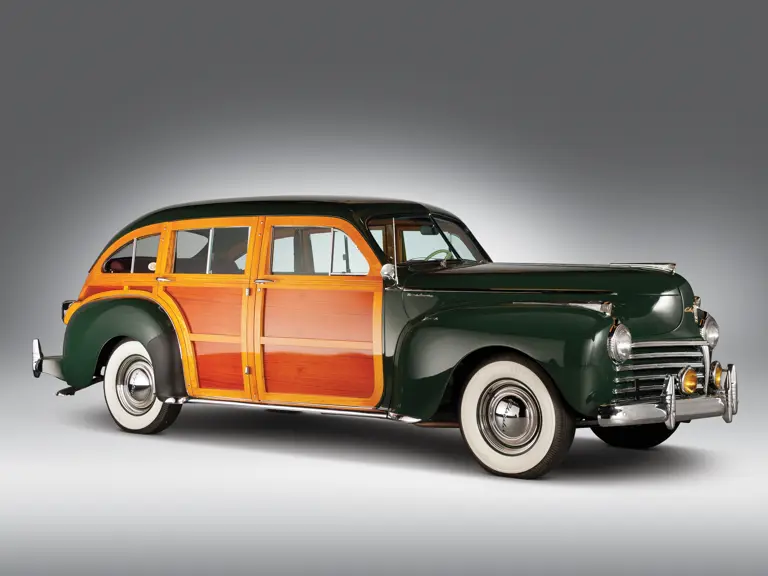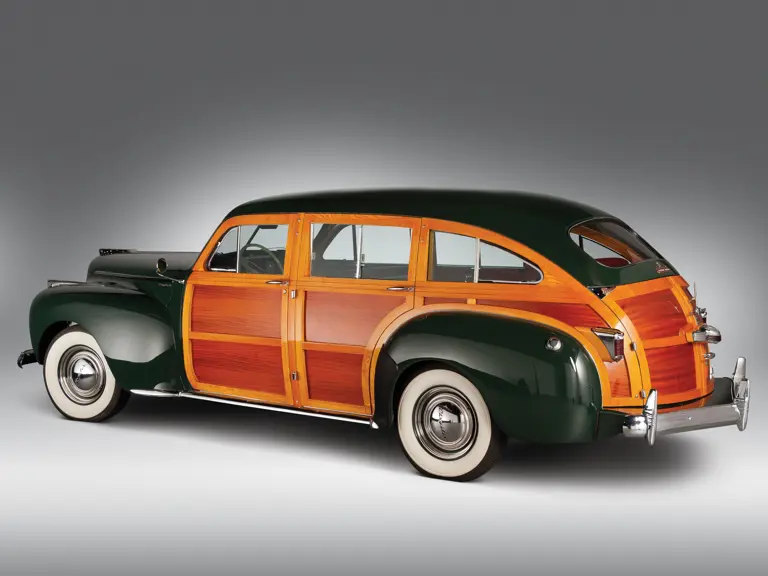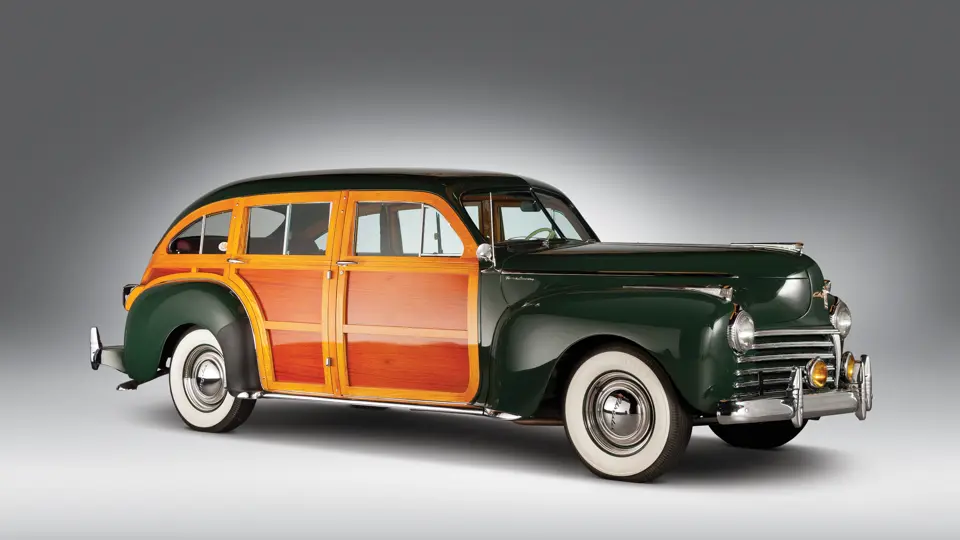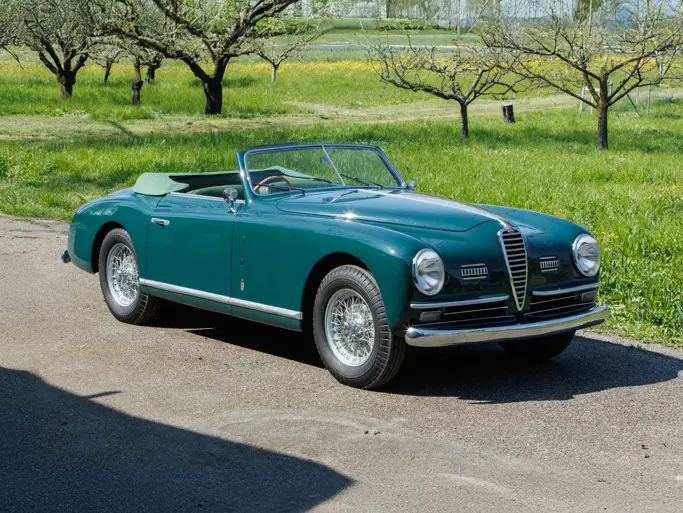Model C-28. 108 bhp, 241.5 cu. in. L-head inline six-cylinder engine, four-speed Vacamatic semi-automatic Fluid Drive transmission, coil spring independent front suspension, live rear axle with semi-elliptic leaf springs, and four-wheel hydraulic drum brakes. Wheelbase: 121.5"
• Distinctive and very rare early “barrelback” with nine-passenger seating
• Excellent restoration
• A concours class-winner with multiple magazine features
In 1941, Chrysler introduced a unique wood-bodied car to the six-cylinder Windsor line. Neither sedan nor station wagon, it had a fastback profile with twin hinged doors at the rear. In contrast to most wood-bodied utility vehicles, the new Town and Country Car, as the company initially called it, had lavishly-varnished wood inside and quality upholstery.
This first edition of the Town and Country has become known as the “barrelback,” from its rounded rear styling combined with “clamshell” rear doors. The doors lead to a large and useful storage area behind the rear passenger seats. An innovation taken for granted today, the rearmost seat could be stowed in a forward position, enlarging the cargo area, or placed rearward, increasing passenger legroom. A nine-passenger version was also offered, with a limousine-type folding bench seat between the two rows of standard seats.
Exactly 999 were built, 200 of them in six-passenger configuration and the rest as nine-seaters. In addition, a single prototype was built on an eight-cylinder chassis. A similar lineup was continued into 1942, with nearly identical production despite the war-shortened model year.
The response to the Town and Country was such that an expanded range was planned for 1946. Seven prototype hardtop coupes were built, along with a single two-door Brougham, but a planned roadster never saw the light of day. Once the assembly lines started rolling, only an eight-cylinder convertible coupe joined the sedan, which was built in both six- and eight-cylinder form. The long-wheelbase eight-cylinder sedans, however, were discontinued after 100 had been completed. The new-design second-series 1949 line dropped the Town and Country sedan, and for 1950 the model retreated to an eight-cylinder hardtop coupe with painted insert panels. Thereafter, the name “Town and Country” designated a long succession of Chrysler steel-bodied station wagons.
This 1941 Chrysler Town and Country is an outstanding nine-passenger example. Finished in Polo Green and trimmed in red leather, it presents a very attractive and stately appearance. The comprehensive, show quality restoration was completed over a five-year period and is documented with a large collection of photographs.
Located by Dave Donley in New Mexico in 2001, the car was eventually purchased by Gerald Greenfield of Seattle, Washington. Gary Dunham performed the exceptional mechanical and cosmetic restoration and fabricated new sills and doorposts to maintain structural integrity in preparation for the wooden bodywork. The car was shipped to Chris Messano Woodworks of San Pedro, California, where the handsome woodwork was added. Greenfield credits several fellow Town and Country Registry and National Woodie Club members for their assistance with the project. Vic McBeth provided his own vehicle for the creation of wood patterns, while Tom Kyser, Bob Brelsford and Harold Mermel provided photos and technical expertise. In addition, Steve Glazier loaned a set of the rare hinges for the unique rear doors, allowing Greenfield to have them reproduced.
Upon completion, the Chrysler was judged Best in Class at the September 2005 Kirkland Concours d’Elegance, held near Seattle. It has also been featured on the cover of the winter 2005 edition of Timber Tales, the magazine of the Town and Country Owner’s Registry. Articles on the restoration process were also featured in the November 2003 and December 2005 editions of Woodie Times, the magazine of the National Woodie Club.
Shortly after its dramatic debut at the Kirkland Concours d’Elegance, the Town and Country caught the eye of collector Art Astor, who purchased it from Gerald and Doreen Greenfield. The Milhous Collection acquired it in 2008. In addition to the complete photographic documentation of the restoration process, the Town and Country comes with a number of highly sought-after items of paraphernalia, including a massive full-color Chrysler dealer display book that contains original upholstery samples, a repair and tune-up manual, a shop manual and a copy of the 2003 edition of the Town and Country owner’s registry.
The car is impressively optioned with an AM radio, a Mopar Deluxe heater, a clock, dual side mirrors, dual Unity spotlights and a period chrome exhaust tip. Beautifully finished and painstakingly maintained, this nine-passenger Town and Country presents a rare opportunity for the serious collector to acquire one of the most attractive, luxurious and rare wood-bodied station wagons ever produced.
Wood-bodied cars have a large following. The Chrysler Town and Country was one of the original crossover vehicles, with the style and practicality of a woodie station wagon and the comfort of a sedan.




 | Boca Raton, Florida
| Boca Raton, Florida


